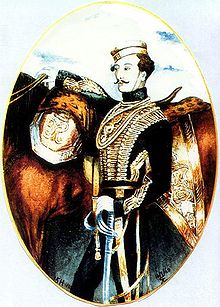|
15th The King's Hussars
The 15th The King's Hussars was a cavalry regiment in the British Army. First raised in 1759, it saw service over two centuries, including the First World War, before being amalgamated with the 19th Royal Hussars into the 15th/19th The King's Royal Hussars in 1922. HistoryEarly wars  The regiment was raised in the London area by George Augustus Eliott, 1st Baron Heathfield as Elliots Light Horse as the first of the new regiments of light dragoons in 1759.[2] It was renamed the 15th Regiment of (Light) Dragoons in 1760.[2] The regiment landed in Bremen in June 1760 for service in the Seven Years' War.[3] The regiment were largely responsible for the victory, suffering 125 of the 186 allied casualties at the Battle of Emsdorf in July 1760. Lieutenant Colonel William Erskine, commanding the regiment, presented King George III with 16 colours captured by his regiment after the battle.[4] During the battle the French commander, Major-General Christian-Sigismund von Glaubitz, was taken prisoner.[5] The regiment charged the French rear guard twice at the Battle of Wilhelmsthal in June 1762[6] and then returned home in July 1763.[7] In 1766 it was renamed for King George III as the 1st (or The King's Royal) Regiment of Light Dragoons, the number being an attempt to create a new numbering system for the light dragoon regiments. Under this name it suppressed the Nottingham cheese riot in October 1766.[2] However, the old system was quickly re-established, with the regiment being renamed as the 15th (The King's) Regiment of (Light) Dragoons in 1769.[2] The regiment landed at Ostend in May 1793 for service in the Flanders Campaign and fought at the Battle of Famars in May 1793.[8] It formed part of the besieging force at the Siege of Valenciennes in June 1793[8] and formed part of the covering force at the Siege of Dunkirk in August 1793[9] and at the Siege of Landrecies in April 1794.[10] It undertook successful charges at the Battle of Villers-en-Cauchies in April 1794[11] and at the Battle of Willems in May 1794[12] and was present, but not actively engaged, at the Battle of Tournay later in May 1794.[13] The regiment returned to England in December 1795[14] and was next in action at the Battle of Alkmaar in October 1799 during the Anglo-Russian invasion of Holland.[14] Napoleonic WarsThe regiment was reconstituted as a hussar regiment in 1807 as the 15th (The King's) Regiment of (Light) Dragoons (Hussars).[2] It landed at Corunna in November 1808 for service in the Peninsular War[15] and defeated two regiments of French cavalry at the Battle of Sahagún in December 1808.[16] At the battle two French lieutenant colonels were captured and the French 1st Provisional Chasseurs à cheval, who lost many men captured, ceased to exist as a viable regiment.[17] However, the commanding officer of the 15th Hussars, Colonel Colquhoun Grant, was wounded in the battle.[18] The regiment embarked at Corunna for their journey home in January 1809.[19] The regiment were ordered to support Sir Arthur Wellesley's Army on the Iberian Peninsula and landed at Lisbon in February 1813.[20] It took part in the Battle of Morales in June 1813[21] and the Battle of Vitoria later in the month.[22] It then pursued the French Army into France and supported the infantry at the Battle of Orthez in February 1814[23] and at the Battle of Toulouse in April 1814.[24] It returned to England in July 1814.[25] The regiment was recalled for the Hundred Days and landed at Ostend in May 1815:[26] it took part in a charge at the Battle of Waterloo in June 1815[27] and returned to England in May 1816.[28] Peterloo  The regiment played a pivotal role in the notorious Peterloo Massacre in August 1819, when a 60,000 strong crowd calling for democratic reform were charged by the Yeomanry. Panic from the crowd was interpreted as an attack on the Yeomanry and the Hussars (led by Lieutenant Colonel Guy L'Estrange) were ordered in. The charge resulted in 15 fatalities and as many as 600 injured.[29] Victorian eraThe title of the regiment was simplified in 1861 to the 15th (The King's) Hussars.[2] It was stationed in Ireland between July 1824 and May 1827[30] and between April 1834 and May 1837.[31] It was then stationed in India between spring 1840 and 1854.[32] The regiment returned to India in 1867 and moved on to Afghanistan in 1878 for service in the Second Anglo-Afghan War before being deployed to South Africa in January 1881 for service in the First Boer War.[32] First World WarThe regiment, which was stationed at Longmoor at the start of the First World War, landed at Rouen in France on 18 August 1914: the squadrons were attached to different infantry divisions to form the divisional reconnaissance element: A Squadron was attached to 3rd Division, B Squadron was attached to 2nd Division and C Squadron was attached to 1st Division. On 14 April 1915, the squadrons returned to regimental control and the regiment was placed under the command of the 9th Cavalry Brigade in the 1st Cavalry Division.[33] The regiment remained on the Western Front throughout the war. It participated in most of the major actions where cavalry were used as a mounted mobile force. They were also used as dismounted troops and served effectively as infantry.[34] On 11 November 1918, orders were received that the 1st Cavalry Division would lead the advance of the Second Army into Germany, by 6 December 1918, having passed through Namur, the division secured the Rhine bridgehead at Cologne.[34] Post warAfter service in the First World War, the regiment, retitled as the 15th The King's Hussars in 1921[2] was amalgamated with the 19th Royal Hussars into the 15th/19th The King's Royal Hussars in 1922.[2] Regimental museumThe regimental collection is held by the Discovery Museum in Newcastle upon Tyne.[35] Battle honoursThe regiment was awarded the following battle honours:[2]
Victoria Cross
Regimental ColonelsColonels of the regiment were:[2]
See alsoReferences
Sources
Further reading
External links
|
||||||||||||||||||||||||||||||
